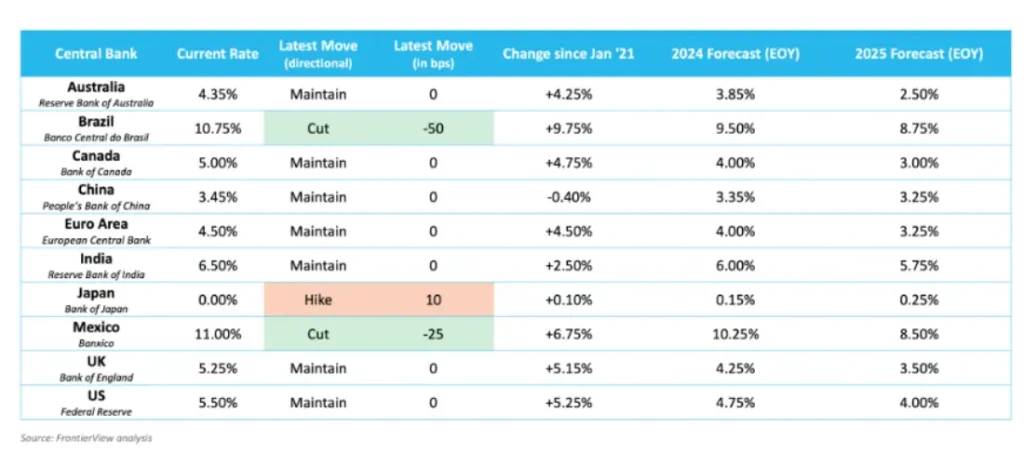
In turn, this will lead to divergent growth prospects
Multinationals should ensure they are updating their assumptions when it comes to inflation and interest rates to reflect recent developments in the global economy: trends in monetary policy are starting to diverge across markets, providing differing growth prospects, operating conditions, and timing when it comes to the recovery of investment and consumer purchasing power. Multinationals should also be cognizant of the fact that, while interest rates will fall in most markets, they are highly unlikely to return to their pre-pandemic levels. Finally, executives should also update their FX assumptions for 2024, to account for a stronger-than-expected US dollar.
Overview
- Interest rates are set to fall in 2024, with several central banks having already started their monetary easing cycle. Lower interest rates will reduce borrowing costs, providing support to overall investment and particularly to rate-sensitive sectors such as real estate.
- However, the timing and pace of rate cuts is likely to diverge substantially across regions and markets, providing contrasting growth prospects and investment opportunities.
- Crucially, interest rates are unlikely to return to pre-pandemic levels in 2024 or 2025.
Our View
Monetary policy across the global economy has been broadly coordinated in the last four years: during the pandemic, most central banks cut their interest rates in order to stimulate activity. In the post-COVID reopening, supply chain snarls and commodity shocks created an inflationary spike, which forced central banks to increase their interest rates.
These global supply chain and commodity shocks are now subsiding, and inflationary pressures are now becoming more region- and country-specific. While China teeters on the edge of deflation as aggregate demand continues to falter, the rest of Asia is grappling with high food inflation, the product of elevated rice prices. In the US, the strength of demand continues to put upward pressure on inflation, notably in services, while more cautious consumers in Europe are allowing price pressures to subside.
The divergence in inflation is engendering a divergence in interest rate policy, which is already evident: most Latin American banks are already underway when it comes to loosening, while others, such as in Indonesia, are being forced to tighten further.
When it comes to the major central banks, a divergence in the timing and scope of rate cuts is also likely: the European Central Bank (ECB) and the Bank of England (BOE) will likely begin their loosening cycle by the early summer, while the Federal Reserve will need to keep rates elevated for longer in order to stamp out stubborn services inflation—a Fed cut before September is unlikely.
Higher-for-longer US interest rates carry several implications. Most importantly, they will keep the dollar strong throughout 2024, weakening the prospect for meaningful currency appreciation in several markets. High US interest rates will also keep dollar-denominated assets attractive and, in doing so, limit other central banks’ ability to reduce their own interest rates—this could put an undue brake on economic activity. Still, we expect overall monetary conditions to loosen in 2024, which will allow for a recovery in business investment, manufacturing, and other rate-sensitive sectors such as real estate and autos.
At FrontierView, our mission is to help our clients grow and win in their most important markets. We are excited to share that FiscalNote, a leading technology provider of global policy and market intelligence has acquired FrontierView. We will continue to cover issues and topics driving growth in your business, while fully leveraging FiscalNote’s portfolio within the global risk, ESG, and geopolitical advisory product suite.
Subscribe to our weekly newsletter The Lens published by our Global Economics and Scenarios team which highlights high-impact developments and trends for business professionals. For full access to our offerings, start your free trial today and download our complimentary mobile app, available on iOS and Android.
